History of the Institute
A short summary about the Institute. Author: Wolfgang Elbert
The years in Berlin
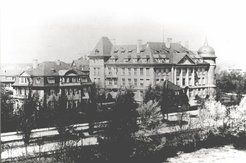
Founded in December 1911, the Kaiser Wilhelm Institute for Chemistry was opened on 23 October 1912. The founding director was Ernst Beckmann (1853-1923), who also directed the Department of Inorganic and Physical Chemistry. The Department of Organic Chemistry was led by Richard Willstatter (1872-1942), who won the Nobel Prize for Chemistry in 1915 for his work on plant pigments.
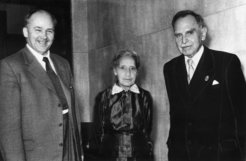
The teamwork of Otto Hahn (1879-1968), Lise Meitner (1878-1968) and Fritz Straßmann (1902-1980) led to the discovery of nuclear fission in December 1938. Otto Hahn was Director of the Institute from 1928 to 1946. He received the Nobel Prize for Chemistry in 1944.

During the war, in 1944, the Institute building was severely damaged as a result of air raids (photo 3). Everything that hadn't been destroyed was then stored in a closed textile factory in Tailfingen, Württemberg (present-day Albstadt), where the Institute continued the work it had started in Berlin for a time.
The years in Mainz
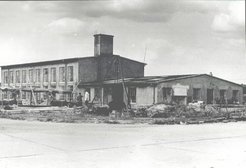

In 1946, Fritz Straßmann managed the construction of a new Institute on the site of the former Flak-Kaserne barracks in Bretzenheim, a stone's throw away from the newly-built university. Repair and renovation work was performed on existing buildings (picture 4), and some new ones were also constructed. But it was only in 1949 that work had progressed sufficiently for the Institute to move from Tailfingen to Mainz.
In the meantime, in the American and British occupied zone, the Kaiser Wilhelm Society was restructured to form the Max Planck Society (MPG) in 1948. Otto Hahn was its first president. The former Kaiser Wilhelm Institutes, which were located in the French zone, and the Mainz Institute, were renamed and incorporated into the MPG in 1949, creating the Max Planck Institute (MPI) for Chemistry in Mainz. At that time, the Institute employed 53 members of staff. (Today, around 150 members of staff hold salaried positions, and a further 100 scholarship holders and visitors are on temporary contracts.)
The institute was officially inaugurated on July 9, 1956 following several years of construction. The Institute also became known as "Otto Hahn Institute" (photo 5). It was expanded in 1961 with the new Nuclear Physics Department building (photo 6), and again in 1985 when a larger building was required for the Department of Atmospheric Chemistry.
More about the foundation of Mainz University (German only).
2012: Move into the new building
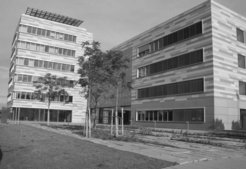
At the beginning of 2012 and after two years of construction, the Institute moved into its new building, which is located at the western edge of the Mainzer campus site and in the immediate vicinity of the Max Planck Institute for Polymer Research. The move became necessary as the old premises could not be renovated in an economic manner. The new building also provides enough space for the new Multiphase Chemistry Department which was founded in October 2012 and is led by PD Dr. Ulrich Pöschl.
In the same year, the Max-Planck-Institute for Chemistry also celebrated its 100. birthday. On this occasion several commemorative events took place. In addition to a historical science colloquium, an official ceremony and a Day of the Open House the exhibition “milestones” was created. This exhibition highlights some of the most important moments in the Institute’s history. Click here to get more information.
100 Years of the Kaiser Wilhelm/Max Planck Institute for Chemistry
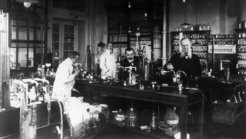
The Mainz Institute celebrated its 100th anniversary on October 23, 2012, as the predecessor institute, the Kaiser Wilhelm Institute for Chemistry, opened its doors in Berlin on October 23, 1912. Towards the end of World War II, the researchers left the founding location and, under their then-director Otto Hahn, temporarily moved to the Swabian Alps. In 1949, the Institute for Chemistry was integrated into the Max Planck Society and found its new home in Mainz.
The research topics of the chemists over the past 100 years were at least as diverse as their research locations: The investigation of plant pigments by Nobel laureate Richard Willstätter was followed in 1938/39 by the discovery of nuclear fission by Otto Hahn, Lise Meitner, and Fritz Strassmann, for which Hahn received the Nobel Prize in 1945. In the 1960s, the institute gained public attention due to its lunar research. And in the 1980s, Nobel laureate Paul Crutzen solidified atmospheric chemistry as a research field with his work on ozone depletion.
Today, the Mainz Institute primarily focuses on the chemical interactions between the Earth and the atmosphere. On the occasion of the anniversary, the scientific symposium "Earth system chemistry: Future perspectives" was held on October 22.






